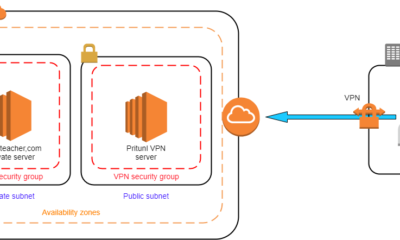DevOps
Setting Up a Git-Driven Deployment System on Linux: Easy Guide
Are you looking to streamline your deployment process while maintaining full control over your code? Setting up a Git-driven deployment system on Linux might just be the solution you need.
Imagine the simplicity of pushing your latest changes and having them automatically deployed without a hitch. This system not only saves you time but also reduces the chance of errors, making your workflow smoother and more efficient. In this guide, you’ll discover how to leverage Git’s powerful features to create a seamless deployment pipeline on your Linux server.
Whether you’re a developer tired of repetitive manual deployments or an IT professional seeking more robust solutions, understanding this setup could transform the way you work. Ready to unlock the potential of Git-driven deployments? Let’s dive in and simplify your development process together.
Prerequisites And Tools
Setting up a Git-driven deployment system on Linux requires basic knowledge of Git and command-line operations. Install Git, a code editor, and access a Linux server to begin. These tools ensure efficient code management and deployment processes.
Setting up a Git-driven deployment system on Linux can be a game-changer for your development workflow. You get to automate and streamline your deployments, making them faster and more reliable. But before you dive in, there are a few prerequisites and tools you need to get started. Let’s explore some key components that will set you up for success.Linux Distribution Options
Choosing the right Linux distribution is crucial. Are you using Ubuntu, CentOS, or perhaps Debian? Each distribution offers unique advantages. Ubuntu is user-friendly and has a vast community support. CentOS, on the other hand, is known for its stability and is a favorite for server environments. Debian is robust and reliable. Picking the right one depends on your specific needs and familiarity.Git Installation
Git is the backbone of your deployment system. It’s essential to have it installed and configured correctly. Installing Git is straightforward. Use the package manager specific to your Linux distribution. For Ubuntu, you can simply run `sudo apt-get install git`. On CentOS, you might use `sudo yum install git`. Ensure that Git is up to date to avoid any compatibility issues.Essential Software Packages
Apart from Git, there are other software packages you should consider. These tools will enhance your deployment experience. SSH is crucial for secure connections to your server. You might also need a web server like Apache or Nginx to host your applications. Don’t forget to install a database system if your application requires it; options like MySQL or PostgreSQL are popular choices. Have you thought about using any monitoring tools? Tools like Nagios can help track the health of your deployments. Can you imagine the time saved with automated monitoring? With these prerequisites and tools in place, you’re ready to take your first steps towards a seamless Git-driven deployment system. Are there any tools or setups you’ve found particularly useful in your Linux environment?
Credit: www.instagram.com
Configuring Git Repositories
Setting up a Git-driven deployment system on Linux simplifies code management. Configure repositories for seamless collaboration and efficient updates. Ensure smooth integration by optimizing repository settings for your specific project needs.
Configuring Git repositories is a fundamental step in setting up a robust Git-driven deployment system on Linux. It’s where you lay the groundwork for seamless collaboration and efficient code management. Whether you’re starting fresh or connecting with existing projects, understanding how to configure repositories is crucial. You’ll be empowered to maintain a structured workflow and streamline your deployment processes.Creating A New Repository
Starting a new repository might seem daunting, but it’s quite straightforward. First, navigate to the directory where you want your project to reside. Simply use the command `git init` to initialize a new Git repository. This creates a `.git` directory that tracks all changes in your project. It’s like having a personal assistant that keeps an eye on every modification you make. Once your repository is set up, remember to create a `.gitignore` file. This file tells Git which files or directories to ignore. For example, you might want to exclude temporary files or system-specific configurations that are irrelevant to your project.Cloning Existing Repositories
What if you want to work on a project that’s already in progress? Cloning is your answer. By cloning a repository, you create a local copy of an existing project on your machine. Use the command `git clone [repository URL]` to download the repository contents. Once cloned, you can start contributing to the project right away. Imagine working with a team; this process allows everyone to access the latest version of the project and make changes without stepping on each other’s toes. The beauty of Git is in its ability to merge changes seamlessly, ensuring everyone stays on the same page.Managing Remote Connections
Remote connections are the bridges that connect your local repositories to the outside world. They enable you to push your changes to a remote server or pull updates from it. Use the command `git remote add origin [remote repository URL]` to link your local repository with a remote one. It’s essential to manage these connections wisely. Regularly check your remote URLs and update them if necessary. This ensures your data flows smoothly between your local environment and the remote server. Have you ever encountered a broken link on a website? Managing your remote connections prevents similar disruptions in your workflow. In configuring your Git repositories, you set the stage for a successful deployment system. How will you leverage these tools to enhance your development process?Deployment Strategy
Deploying software using Git on Linux ensures smooth updates and version control. This setup streamlines development and deployment, reducing errors. By integrating Git, developers can efficiently manage code changes and automate deployments, enhancing productivity.
Setting up a Git-driven deployment system on Linux can seem daunting at first, but with a well-thought-out deployment strategy, the process can become straightforward and efficient. A deployment strategy is your plan of action for releasing software updates smoothly and effectively. It minimizes downtime and ensures that your latest changes are correctly integrated. By choosing the right deployment methods, setting up branching models, and automating deployment tasks, you can streamline your deployment process.Choosing Deployment Methods
Selecting the right deployment method is crucial. You might choose a manual deployment, where you push updates yourself. It gives you control but can be time-consuming. Alternatively, automated deployment can save you time and reduce human error. It’s like setting up a well-oiled machine that works while you focus on other tasks. Have you considered the blue-green deployment strategy? It allows you to switch traffic between two environments seamlessly, reducing downtime and risks. Think about your project’s specific needs to decide which method suits you best.Setting Up Branching Models
Branching models are the backbone of your deployment strategy. A popular choice is Git Flow, which provides a structured approach with branches for features, releases, and hotfixes. For a simpler option, GitHub Flow offers a streamlined process with a single master branch for live releases. It’s ideal if you want less complexity in your workflow. Consider your team’s size and workflow. A small team might benefit from a simpler model, while larger teams may need more structure. What’s your team’s preference?Automating Deployment Tasks
Automation is your friend in deployment tasks. With tools like Jenkins or GitLab CI/CD, you can automate testing, building, and deploying your code. Imagine the time saved by not having to manually check every detail. Automation ensures consistency and reliability in your deployments. Don’t overlook hooks in Git. They can trigger scripts during different stages of your deployment process, adding another layer of automation. Have you explored these options yet? By focusing on these strategies, you can transform your deployment process from a potential headache into a smooth and efficient operation. What’s your next step in improving your deployment strategy?Setting Up Ssh For Secure Transfers
Setting up SSH for secure transfers is a crucial step in establishing a Git-driven deployment system on Linux. This ensures that your code travels safely between your local environment and the server. You’ll want to avoid any security vulnerabilities, especially when dealing with sensitive data. With SSH, you can encrypt your connections, making it nearly impossible for unauthorized users to intercept your transfers. But how exactly do you set it up? Let’s dive into the practical steps involved.
Generating Ssh Keys
Creating SSH keys is your first step toward secure transfers. Think of SSH keys as a lock and key system where you hold the key. Use the command line to generate a pair of keys—a public key that you share and a private one that you keep secret.
Run the command: ssh-keygen -t rsa -b 4096. You’ll be prompted to save the keys in a directory. Choose a location that’s easy for you to remember.
Once done, you’ll find two files: one with a .pub extension (your public key) and another without (your private key). Are you ready to move forward?
Configuring Ssh Access
Now that you have your keys, it’s time to configure SSH access on your server. You need to add your public key to the server’s authorized_keys file. This file acts as a whitelist for SSH access.
Use the command: ssh-copy-id user@server_address. This adds your public key to the server’s authorized_keys file automatically.
Ensure your server’s SSH settings allow key-based authentication. Double-check the sshd_config file for the line PubkeyAuthentication yes. Are you confident in your configuration?
Testing Ssh Connections
After setting up your keys and configuring access, it’s time to test the connection. You want to make sure everything works smoothly before proceeding to deployment.
Attempt to connect to your server using SSH: ssh user@server_address. If successful, your terminal should prompt you with a welcome message from your server.
If the connection fails, retrace your steps. Check your public key placement and permissions. Troubleshooting can be frustrating, but it’s crucial for securing your system. Are you ready to troubleshoot if necessary?
Setting up SSH for secure transfers isn’t just a technical step; it’s a safeguard for your work. As you proceed, remember that security is a continuous process. What steps will you take to ensure your code stays protected?
Integrating With Ci/cd Tools
Set up a Git-driven deployment system on Linux to streamline CI/CD integration. This setup automates code deployments, ensuring efficient and consistent updates. Linux’s flexibility enhances deployment workflows, minimizing errors and saving time.
Integrating with CI/CD tools enhances your Git-driven deployment system. It automates processes, ensuring smoother deployments. CI/CD tools help in building, testing, and deploying code faster. They provide a seamless integration with your existing Linux environment. This ensures that your applications remain up-to-date and functional.Choosing Ci/cd Platforms
Selecting the right CI/CD platform is crucial. Consider compatibility with your Linux setup. Popular options include Jenkins, GitLab CI, and Travis CI. Evaluate based on features and ease of use. Some platforms offer excellent community support. Others focus on extensive plugin ecosystems. Ensure the platform fits your team’s needs.Configuring Build Pipelines
Build pipelines automate the process of code integration. Start by defining stages, like build, test, and deploy. Use the CI/CD platform’s interface to configure these stages. Each stage should have clear input and output. This ensures smooth transition between stages. Implement triggers for automatic builds. This enhances efficiency and reduces manual intervention.Deploying With Continuous Integration
Continuous integration ensures code is always ready for deployment. It automatically merges changes into the main branch. This keeps the code base consistent. Set up automated tests to validate changes. Use the CI/CD tool to deploy successful builds. This reduces errors and downtime. Monitor deployments to ensure they meet expectations.
Credit: www.reddit.com
Monitoring And Logging
Setting up a Git-driven deployment system on Linux requires effective monitoring and logging. Track changes efficiently to ensure smooth deployments. Logs offer valuable insights into system performance and error detection, enhancing reliability.
Setting up a Git-driven deployment system on Linux is a powerful method to streamline your development workflow. However, without effective monitoring and logging, you might find yourself in a maze of errors and performance issues. It’s crucial to keep an eye on your deployments to ensure everything runs smoothly. Monitoring and logging not only help in identifying problems but also play a key role in optimizing the system. You might recall a time when a simple log entry saved you hours of debugging. Let’s dive into how you can effectively set up these systems.Implementing Monitoring Tools
Start with choosing monitoring tools that best fit your needs. Tools like Nagios and Prometheus offer robust solutions for tracking server health and performance metrics. These tools can alert you to CPU spikes, memory leaks, or network issues. Consider setting up dashboards for real-time insights into your server’s status. Ask yourself: What metrics are most crucial for my deployment? Tailor your monitoring setup to focus on those critical elements.Setting Up Log Management
Effective log management is the backbone of any deployment system. Choose log management tools such as Logstash or Fluentd to collect and process logs efficiently. Organize your logs so you can quickly locate information when troubleshooting. Implement log rotation to manage disk space and ensure older logs don’t clutter your system. Have you ever faced a situation where a missing log entry led to hours of searching? Proper log management can prevent such scenarios.Analyzing Deployment Logs
Analyzing logs is where the magic happens. Tools like ELK Stack can help you visualize and search through logs effortlessly. Look for patterns or anomalies that could indicate issues. Regularly review logs to spot trends that could affect future deployments. Consider: Are there recurring errors that need attention? Analyzing logs can help you address these before they become critical problems. Monitoring and logging are not just tasks; they are your allies in maintaining a robust deployment system. With the right tools and strategies, you can turn potential headaches into manageable insights.Troubleshooting Common Issues
Setting up a Git-driven deployment system on Linux offers many benefits. Yet, sometimes, issues arise that can slow down your workflow. This section will guide you through common problems and their solutions. Understanding these challenges will help maintain your deployment system efficiently.
Handling Git Conflicts
Git conflicts occur when changes overlap. To resolve, identify conflicting files. Use the Git command git status to see conflicts. Open the files and edit manually. Look for conflict markers in the code. Remove them after resolving differences. Test the code to ensure functionality.
Resolving Ssh Errors
SSH errors can disrupt deployment. First, check your SSH keys. Ensure they are correctly configured. Use ssh-keygen to generate a new key if needed. Next, verify server accessibility. Test by running ssh -T git@yourserver.com. Confirm that the firewall is not blocking SSH. Adjust settings if necessary.
Fixing Deployment Failures
Deployment failures can occur for various reasons. Start by checking logs for error messages. Logs provide clues about the issue. Ensure the server has sufficient resources. Low memory or disk space can cause failures. Update software dependencies regularly. Outdated libraries may lead to errors. Lastly, verify file permissions. Incorrect permissions can halt deployment.

Credit: www.facebook.com
Frequently Asked Questions
How Do I Set Up Git On Linux?
To set up Git on Linux, start by installing it using your package manager, like `apt` or `yum`. After installation, configure your user name and email with `git config`. This ensures your commits are correctly attributed. Now, you can initialize repositories and start tracking changes efficiently.
What Is Git-driven Deployment?
Git-driven deployment automates code delivery from repositories to production. It uses Git hooks or CI/CD tools to streamline updates. This approach ensures consistent, rapid, and reliable deployments. It reduces human errors and enhances collaboration among development teams, making deployments more seamless and efficient.
Why Use Git For Deployment On Linux?
Using Git for deployment on Linux provides robust version control and easy rollback options. It integrates well with Linux’s command-line tools and scripting capabilities. This setup enhances collaboration, automates deployments, and ensures consistency. Git’s flexibility and reliability make it ideal for managing complex software projects.
Can I Automate Deployments With Git?
Yes, you can automate deployments with Git using hooks or CI/CD pipelines. Tools like Jenkins, Travis CI, or GitHub Actions facilitate this process. They automatically trigger deployments on code changes. This improves efficiency, reduces manual errors, and ensures consistent delivery across environments.
Conclusion
Setting up a Git-driven deployment system on Linux is straightforward. It simplifies code management and deployment. You save time and reduce errors. First, understand Git basics. Then, configure your Linux environment. Automate deployments with scripts. Monitor and maintain your system regularly.
Troubleshoot issues promptly. This system boosts efficiency and consistency. Developers and teams benefit greatly. Collaboration improves. Code changes are tracked and easily deployed. Start small and scale as needed. Experiment with features. Customize for your needs. Enjoy smoother workflows. Embrace this method for improved productivity and reliability.
-

 DevOps6 years ago
DevOps6 years agoSaltstack Tutorial for beginners [2025]
-

 DevOps6 years ago
DevOps6 years agoHow to build a Docker cron job Container easily [2025]
-

 Linux6 years ago
Linux6 years agomail Command in Linux/Unix with 10+ Examples [2025]
-

 DevOps6 years ago
DevOps6 years agoDocker ADD vs COPY vs VOLUME – [2025]
-

 DevOps6 years ago
DevOps6 years agoHow to setup Pritunl VPN on AWS to Access Servers
-

 Linux6 years ago
Linux6 years agoGrep Command In Unix/Linux with 25+ Examples [2025]
-

 Linux6 years ago
Linux6 years agoFind command in Unix/Linux with 30+ Examples [2025]
-
Linux5 years ago
How To setup Django with Postgres, Nginx, and Gunicorn on Ubuntu 20.04

